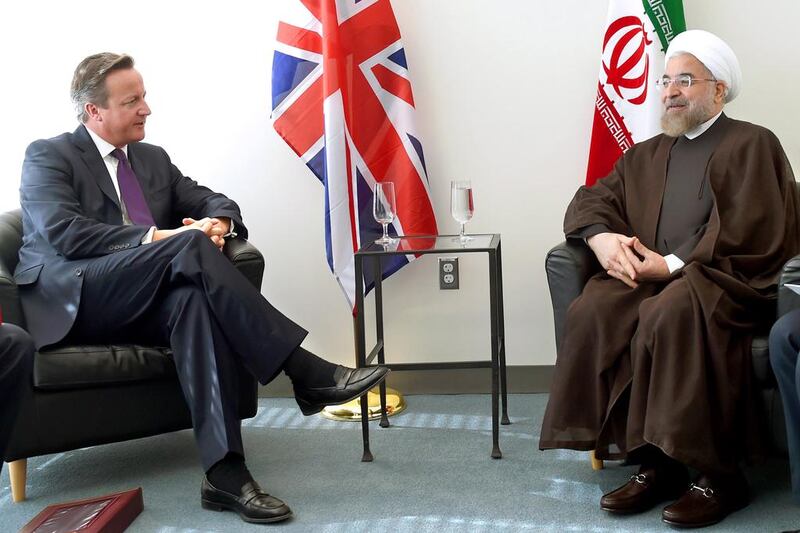In a sign that frosty relations between Iran and the West continue to thaw, David Cameron met Hassan Rouhani at the UN in New York late last month – the first encounter between a British prime minister and an Iranian president since the 1979 Islamic revolution. The meeting is the latest indicator that, after years of isolation, Iran is positioning itself for the potential lifting of international sanctions, a move that would revive the Islamic republic’s ailing energy industry, pave the way for its return as a major oil exporter and provide much-needed stimulus to the domestic economy.
Pending a final, comprehensive deal on the country’s controversial nuclear programme between Tehran and the five permanent UN Security Council members plus Germany (P5+1), relations with the rest of the world for the Islamic republic could return to normal as early as next year, a development that would not only reverse the fortunes of its struggling economy; it would also open the biggest bonanza for international energy companies since the removal of the Iraqi president Saddam Hussein in 2003.
Iran, holder of the world’s fourth-largest proved oil and the second-largest proved natural gas reserves, has been hard hit by UN and international sanctions imposed on the country in 2006 and 2010 on top of existing US sanctions. But it was the latest set of even more stringent measures enacted by the US and the European Union in late 2011 and 2012 that had the most devastating effect.
According to the IMF’s latest Article IV Consultation report on Iran, published in April, the sanctions have constricted the economy, with real GDP declining by almost 6 per cent year-on-year in 2012-13 and by about 2.5 per cent during the first half of 2013-14. Between June 2012 and February 2014, Iran recorded negative GDP growth for seven consecutive quarters.
The embargoes have prevented Iran’s energy sector from securing much-needed foreign investment, technology and expertise, stymying developments, especially in upstream oil and gas. Many projects have been cancelled or delayed. As a result, the country has struggled to expand production capacity at its oil and gasfields, and to halt and reverse declines at its mature fields.
Since the latest round of stringent sanctions was levied on Tehran, the situation has dramatically worsened. The sanctions led to a 1 million barrel per day drop in crude and condensate exports in 2012 versus the previous year. Once Opec’s second-largest oil producer, Iran now ranks behind Iraq in terms of oil and liquids production, averaging only about 3.2 million bpd in 2013, compared with about 4.2 million bpd in 2011.
The economic price of falling oil production and exports in particular has been hefty. According to IMF figures, Iran’s oil and gas export revenues slumped by 47 per cent to US$63 billion in the 2012-13 fiscal year from $118bn a year earlier. The IMF estimates that oil and gas export revenues declined by another 11 per cent to $56bn in the 2013-14 fiscal year.
Few would disagree that Iran has the potential to reclaim its status as an energy giant. But it won’t be an easy task. The sector’s infrastructure is in dire need of rehabilitation and upgrading worth tens of billions of dollars. Moreover, decline rates at the country’s oilfields are high, ranging from 8 to 11 per cent, while recovery rates are quite low at 20 to 25 per cent, according to the energy consultancy FGE and the Arab Oil and Gas Journal. The country will have to introduce and apply advanced technologies and techniques such as enhanced oil recovery (EOR), which it hasn’t been able to get its hands on because of sanctions, on a much greater scale to maintain and boost output.
The need for Iran to invest in its oil and gas sector is obvious. In a bid to create an environment more conducive to attracting foreign investment, the oil minister Bijan Namdar Zanganeh – appointed following last year’s election of the president Hassan Rouhani – has started working on a new oil and gas contract model for international companies.
The Iran Petroleum Contract (IPC) is set to replace the unpopular buyback contract that was introduced in the 1990s. Mohsen Shoar, the managing director at Dubai-based Continental Energy DMCC and an expert on Iranian energy, says the new IPC varies markedly from the buyback model in that it proposes the establishment of a joint venture between National Iranian Oil (or one of its subsidiaries) and a foreign partner for field exploration, appraisal, development and – for the first time since 1979 – production.
Unlike the short nature of the buybacks, the IPC model will offer extended contract duration of 20 to 25 years, allowing for much longer cost recovery after first production. There will also be a provision for the contract to extend into EOR phases. On top of this, there will be, for example, a risk-reward element linked to the complexity of fields that pays companies higher fees for “very high risk” on and offshore fields compared with “low-risk onshore” fields.
Overall, the increased flexibility and improved terms offered under the IPC will provide some incentive for foreign investors to consider a return to Iran’s oil and gas sector if and when sanctions are lifted. However, challenges remain. Mr Shoar says, among other issues, IOCs may be concerned over too much interference into operations by the local joint venture party.
Iran’s new contract model has the potential to change the country’s economic fortunes. It all depends now on world powers and Tehran to come to an agreement that will result in the lifting of sanctions.
Sean Evers is a managing partner at Gulf Intelligence, a strategic communications company based in Dubai
Follow The National's Business section on Twitter





